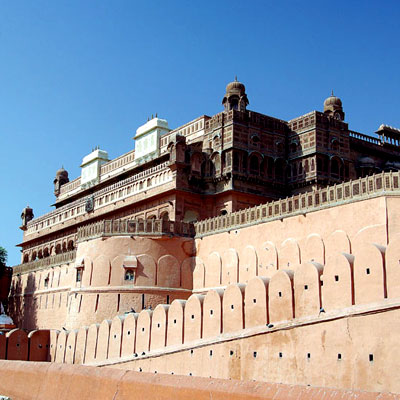Exploring Bikaner: A Vibrant Fusion of History, Culture, and Camel Adventures
Bikaner, located in northern Rajasthan, is one of the region's oldest cities and a shining example of the state's rich heritage. Known for its stunning forts, palaces, and expansive sand dunes, Bikaner, often referred to as "Camel Country," also holds a fascinating connection to a British biplane from the First World War. Renowned for its red sandstone architecture, Bikaner is home to the formidable Junagarh Fort, built in 1588 AD by Raja Rai Singh, a key minister in Akbar's army. This fort complex features stunning palaces constructed from red sandstone and marble, with a mesmerizing array of courtyards, balconies, kiosks, and windows. Notably, Junagarh Fort has never been conquered. Bikaner is famous for possessing some of the world’s finest camels, always ready for a ride. It is home to the largest camel breeding and research center in the world. The National Research Centre for Camel, just 8 km from the city center, is Asia’s only exclusive camel breeding and research facility, managed by the Indian government over 2,000 acres. For many Europeans and Americans, the Rat Temple, or Karni Mata Temple in Deshnok, comes as a cultural shock because it provides food for rats. This site is not for the faint-hearted but offers a unique cultural experience. The majestic Lalgarh Palace and Museum, made of red sandstone and envisioned in 1902 by Sir Swinton Jacob, incorporates elements of European, Rajput, and Islamic architecture. The Laxmi Niwas Palace, once the residence of Maharaja Ganga Singh and designed by Sir Samuel Swinton Jacob between 1898 and 1902, showcases the Indo-Saracenic architectural style and now serves as a luxury hotel for both domestic and international guests. Bikaner’s premier museum, the Ganga Government Museum, houses an extensive collection from Early Gupta and Harappan civilizations. It boasts sections dedicated to Rajput weaponry, artwork, crafts, carpets, pottery, and ancient coins, providing a deep dive into the region's rich history. The best time to visit Bikaner, like much of Rajasthan, is from October to March. The Camel Festival in January is particularly noteworthy, drawing visitors from all over the world. Rail: Lalgarh Railway Junction and Bikaner Junction are conveniently located near the urban center. Air: Nal Airport, the closest airport, is just 13 km from Bikaner, while Jodhpur Airport is 250 km away. Road: Bikaner's roads are relatively smooth, and travel by tongas and autorickshaws offers a unique local experience. What is the best time to visit Bikaner? The best time to visit Bikaner is from October to March, with the Camel Festival in January being a highlight. How can I reach Bikaner by air? The closest airport is Nal Airport, 13 km from Bikaner, while Jodhpur Airport is 250 km away. What are the main attractions in Bikaner? Key attractions include Junagarh Fort, Lalgarh Palace and Museum, Laxmi Niwas Palace, the Karni Mata Temple, and the National Research Centre for Camel. Is Bikaner a good destination for camel-related activities? Yes, Bikaner is known as "Camel Country" and is home to the largest camel breeding and research center in the world. What can I expect to see at the Ganga Government Museum? The Ganga Government Museum houses collections from Early Gupta and Harappan civilizations, Rajput weaponry, artwork, crafts, carpets, pottery, and ancient coins. 
Historical and Cultural Significance
Camel Breeding and Research
Unique Attractions
Museums and Heritage
Climatic Conditions
Travel Information
FAQs